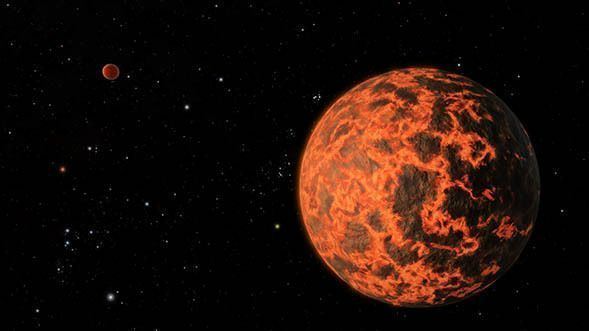Surface temperature 3,318 K Magnitude 10.67 Apparent magnitude (V) 10.67 | Radius 292,300 km (0.42 R☉) | |
 | ||
Mass 8.155 × 10^29 kg (0.41 M☉) Similar Gliese 436 b, Gliese 876, 55 Cancri, TrES‑2b, 55 Cancri e | ||
Exoplanet gliese 436b warm neptune gj 436b
Gliese 436 is a red dwarf approximately 33.1 light-years (10.1 parsecs) away in the zodiac constellation of Leo. It has an apparent visual magnitude of 10.67, which is much too faint to be seen with the naked eye. However, it can be viewed with even a modest telescope of 2.4 in (6 cm) aperture. In 2004, the existence of a transiting extrasolar planet, Gliese 436b, was verified as orbiting the star. In 2012, the existence of a second planet, UCF-1.01, was also verified.
Contents
- Exoplanet gliese 436b warm neptune gj 436b
- Properties
- Planetary system
- Possible second planet
- Two sub Earth candidates
- References
Properties
Gliese 436 is a M2.5V star, which means it is a red dwarf. Stellar models give an estimated size of about 42% of the Sun's radius. The same model predicts that the outer atmosphere has an effective temperature of 3,318 K, giving it the orange-red hue of an M-type star. Small stars such as this generate energy at a low rate, giving it only 2.5% of the Sun's luminosity.
Gliese 436 is older than the Sun by several billion years and it has an abundance of heavy elements (with masses greater than helium-4) equal to 48% that of the Sun. The projected rotation velocity is 1.0 km/s, and the chromosphere has a low level of magnetic activity. Gliese 436 is a member of the "old-disk population" with velocity components in the galactic coordinate system of U=+44, V=−20 and W=+20 km/s.
Planetary system
The star is orbited by one known planet, designated Gliese 436 b. The planet has an orbital period of 2.6 Earth days and transits the star as viewed from Earth. It has a mass of 22.2 Earth masses and is roughly 55,000 km in diameter, giving it a mass and radius similar to the ice giant planets Uranus and Neptune in the Solar System. In general, Doppler spectroscopy measurements do not measure the true mass of the planet, but instead measure the product m sin i, where m is the true mass and i is the inclination of the orbit (the angle between the line-of-sight and the normal to the planet's orbital plane), a quantity that is generally unknown. However, for Gliese 436 b, the transits enable the determination of the inclination, as they show that the planet's orbital plane is very nearly in the line of sight (i.e. that the inclination is close to 90 degrees). Hence the mass quoted is the actual mass. The planet is thought to be largely composed of hot ices with an outer envelope of hydrogen and helium, and is termed a "hot Neptune".
GJ 436 b's orbit is likely misaligned with its star's rotation. In addition the planet's orbit is eccentric. Because tidal forces would tend to circularise the orbit of the planet on short timescales, this suggested that Gliese 436 b is being perturbed by an additional planet orbiting the star.
Possible second planet
In 2008, a second planet, designated "Gliese 436 c" was claimed to have been discovered, with an orbital period of 5.2 days and an orbital semimajor axis of 0.045 AU. The planet was thought to have a mass of roughly 5 Earth masses and have a radius about 1.5 times larger than the Earth's. Due to its size, the planet was thought to be a rocky, terrestrial planet. It was announced by Spanish scientists in April 2008 by analyzing its influence on the orbit of Gliese 436 b. Further analysis showed that the transit length of the inner planet is not changing, a situation which rules out most possible configurations for this system. Also, if it did orbit at these parameters, the system would be the only "unstable" orbit on UA's Extrasolar Planet Interactions chart. The existence of this "Gliese 436 c" was thus regarded as unlikely, and the discovery was eventually retracted at the Transiting Planets conference in Boston, 2008.
Despite the retraction, studies concluded that the possibility that there is an additional planet orbiting Gliese 436 remained plausible. With the aid of an unnoticed transit automatically recorded at NMSU on January 11, 2005, and observations by amateur astronomers, it has been suggested that there is a trend of increasing inclination of the orbit of Gliese 436 b, though this trend remains unconfirmed. This trend is compatible with a perturbation by a planet of less than 12 Earth masses on an orbit within about 0.08 AU of the star.
Two sub-Earth candidates
In July 2012, NASA announced that astronomers at the University of Central Florida, using the Spitzer Space Telescope, strongly believe they have observed a second planet. This strong candidate planet was given the preliminary designation UCF-1.01, after the University of Central Florida. It was measured to have a radius of around two thirds that of Earth and, assuming an Earth-like density of 5.5 g/cm3, was estimated to have a mass of 0.3 times that of Earth and a surface gravity of around two thirds that of Earth. It orbits at 0.0185 AU from the star, every 1.3659 days. The astronomers also believe they have found some evidence for an additional planet candidate, UCF-1.02, which is of a similar size, though with only one detected transit its orbital period is unknown. If these planets are confirmed in the future, they may be given the designations "Gliese 436 c" and "Gliese 436 d".
